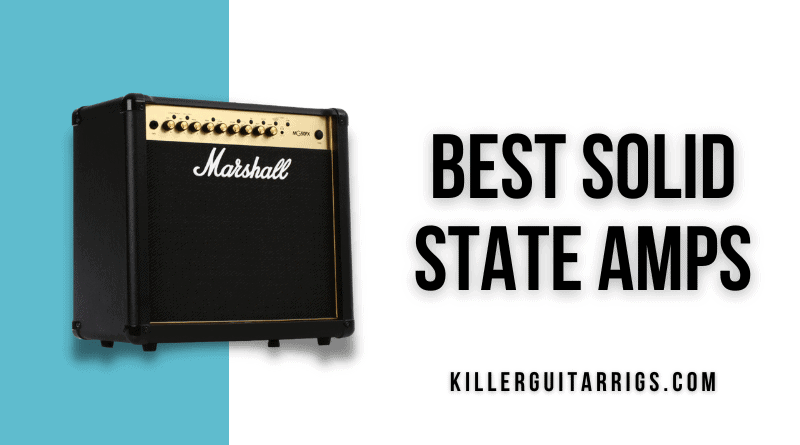It’s a tired old trope that tube amps are always better than solid-state amps. Despite the fact that solid-state amps were originally intended to replace the antiquated vacuum tube technology, many remain convinced that solid-state amps can’t compete.
In reality, there are many frankly amazing solid state amps on the market that create unique tones that really can’t be replicated with a tube amp. They offer tons of clean headroom, making them ideal for pedal users, and thanks to modern digital technology, many even accurately replicate legendary tube amps of the past at a fraction of the cost.
In this KillerGuitarRigs Review, we’ve compiled a roundup of the 7 Best Solid-State Amps around today. We’ve covered everything from entry-level models to pro-level amps, evaluating them based on construction quality, ease of use, features, and tone.
If you’re in the market for a solid state amp, you’ll definitely want to keep on reading.
Read more about our review process.
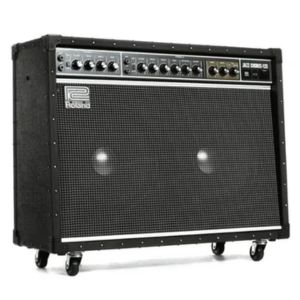
Roland JC-120 Jazz Chorus
Features: Bright switch, Dual 60W power amps, Spring reverb
Benefits: Slices through any mix, Incredible pedal platform, Rock solid construction
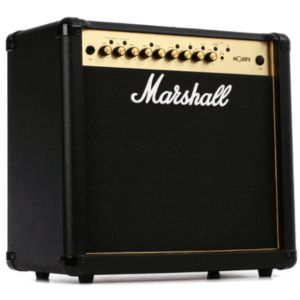
Marshall MG50GFX
Features: Custom 12" speaker, 4 channels, Preset channel modes
Benefits: Easy to recall previous settings, Classic Marshall tone, Enough power for medium gigs
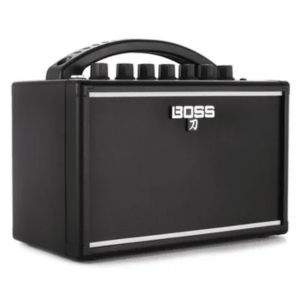
Boss Katana Mini
Features: 3 Amp voicings, Built in delay, 3 Band EQ
Benefits: Super lightweight, Great battery life, Incredible sound quality
Contents
Our Top 3
Players looking for an amp that offers high performance while keeping the price in check should take a look at our Top Pick, the Marshall MG50GFX. It offers a range of great tones from crystal-clear cleans all the way through to the archetypal Marshall distortion.
If you’re looking for a good quality solid-state amp without breaking the bank, our Best Budget pick will be right up your alley. The Boss Katana Mini offers excellent sound quality, extreme portability, and a huge range of tones, considering its diminutive size.
Of course, if you just want the best regardless of cost, there’s no better option than our Editor’s Choice, the Roland Jazz Chorus JC-120. This is a legendary pro-grade amp that offers an incredible feature set and the best solid-state tone bar none.
Individual Reviews
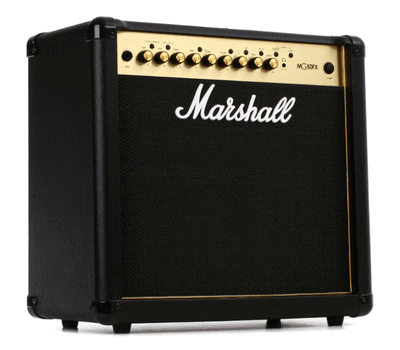
Marshall MG50GFX
Powerful, reliable, and plenty of features.
This is a user friendly amp that will perform equally as well on stage as it does for practice in the house. It packs an impressive 50 watts into a relatively compact cabinet, and comes with plenty of features, including built in FX, a tuner, and even speaker emulated line out.
The Marshall MG50GFX is a fantastic amp with a lot to offer (read our full review here). It serves up proper Marshall mojo but without the huge weight (and price) associated with its tube-powered cousins. It weighed in at 37 pounds, which seemed like a featherweight compared to the 58.4-pound weight of their 50-watt tube model, the JVM215C.
Its cabinet was constructed from medium-density fiberboard (MDF) which gave it a solid feel and good acoustic performance. Inside the cab was a custom 12” speaker that provided great responsiveness and tight tones across the entire frequency spectrum.
The control panel was well laid out and simple to use. There were a total of 4 channels, including Clean/Crunch and OD1/OD2. From this selection, we were able to get a good range of tones from nice, bright cleans to JCM800-style distortion.
This 50-watt amp moves enough air to handle even medium-sized venues and has more than enough volume to keep up with an enthusiastic drummer. It came with a 2-button footswitch in the box, which made it easy to move between channels on the fly.
There was a full 3-band EQ, which allowed us to accurately shape our tones. It also had a pretty full-featured FX selection, which featured reverb, chorus, delay, and a tap tempo switch. On top of these features, it even had a built-in tuner.
Verdict: The Marshall MG50GFX is a great choice if you’re looking for an amp that can do it all. It’s well built, offers plenty of features and great tones, and for a 50-watt amp, it’s actually very affordable. The FX section is a nice addition, providing additional depth and textures for your tone, saving you from having to splash out on pedals right away.
- 50 watts of power
- Easy sound shaping
- Built in tuner
- FX can be difficult to cycle through
- FX could be better quality
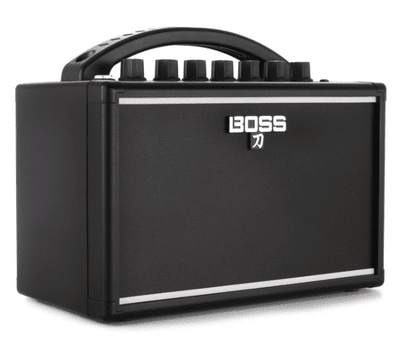
Boss Katana Mini
Perhaps the best mini amp ever made.
This is a hugely capable modeling amp packed into a tiny form factor. With its punchy 4” speaker and 7 watts of power, it has more than enough volume for practice and even impromptu jams. Not only does it deliver excellent sound quality, it offers a range of amp voicings powered by Boss’ legendary modeling engine.
The Boss Katana Mini was a revolution when it was first released. It was the first mini amp that could seriously compete with, and even surpass, the traditional 10-15 watt combo practice amp in terms of sound quality. And it completely blew the almost toy-like mini and micro amps available from other brands out of the water.
It came in a rugged plastic housing, which was durable and helped keep the weight down. Coming in at just 2.6 pounds this was by far the lightest unit in the whole roundup. We found ourselves particularly impressed with the 4″ speaker. It was crisp and composed, and even with just 7 watts of power available, was much fuller sounding than expected.
As for the controls, it had a surprisingly full-featured layout. It was simple to use, yet had all the features we needed to dial in our tones. There were 3 distinct amp voicings: Clean, Crunch, and Brown. These are three of the most popular settings from the bigger Katana amps and each performed well, with sharp cleans, soft distortion from the crunch setting, and big ’80s hair metal leads from the Brown voice.
If you understand its limitations volume-wise, you’ll love it. It’s not going to keep up with a set of acoustic drums, but by using its aux-in feature you can absolutely play along with a drum track or full backing track.
Amazingly, for such a small amp, it had a full 3-band EQ and even a nice delay effect. Sound shaping was easy thanks to the intuitive layout, and having the built-in delay effect allowed us to create more of an ambient tone than is usually possible with mini amps.
Verdict: The Boss Katana Mini is a fantastic little amp that offers a big sound in a tiny package. The built-in amp voicings are as good as you’ll find on bigger Katana models, delivering an exceptional range of tones. Ultimately, it has everything you need for home use, and because it has dual power options (battery and DC) it’s a true “go anywhere” type of amp.
- Small and light
- Powerful sound
- 3 amp voices
- Not loud enough for gigging
- No USB interface functionality
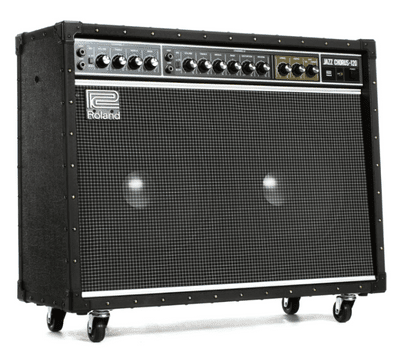
Roland JC-120 Jazz Chorus
The gold standard in solid state amps.
For decades, this amp has been a staple in many guitar players’ rigs. It is a classic amp that has been used on countless hits, and no doubt will be featured on many more. It's a 120 watt behemoth, with some of the prettiest high volume cleans you'll ever hear, and an uncanny ability to take pedals.
The Roland Jazz Chorus JC-120 is a legendary solid-state amp that’s been in continuous production since 1975. It has become one of the most popular amps of all time, and its versatility and amazing tones have made it a favorite among players of all genres.
The amp is built like a tank, with heavy-duty tolex all around and both edge and corner protectors. It had dual 12-inch speakers and a massive 120 watts of power, making it one of the most capable solid-state amps on the market.
It had 2 channels, and an individual control array for each. Channel 1 gave us some of the best cleans we’ve ever heard from any amp and when we activated the chorus function, we understood the hype immediately.
Channel 2 gave us a great range of tones, from decent cleans all the way through to a really robust, yet uniquely solid-state distortion, which worked well for modern metal styles.
Having two speakers and stereo capability, it really brought the built-in vibrato effect to life. When combined with the chorus effect, we got some truly ethereal tones that we don’t think we could possibly get from any other amp without additional pedals.
Verdict: The Roland JC-120 Jazz Chorus is an iconic amp that still stands out even after almost 50 years in production, offering a full spectrum of great tones and iconic chorus effects. It’s expensive, but worth every penny if you want to invest in quality. When it comes to solid-state amps, they simply don’t get better than this.
- Classic orange looks
- Excellent build quality
- FX loop for pedal users
- Cleans are a little thin
- Headphone out only accepts 1/4" jacks
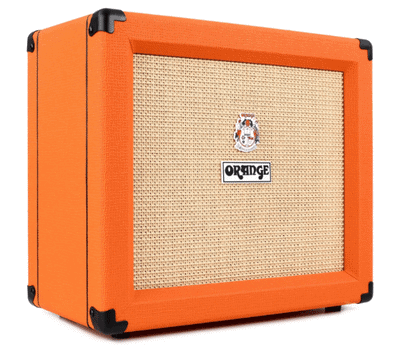
Orange Crush 35RT
Classic British tones at an attainable price.
This 35 watt, solid state combo is a great choice for players looking for a reliable amp that nails the British sound. It's great for practically every genre of rock, and can even handle heavier styles like metal, too. It's a great option for solo practice, and it even has enough power to handle low key jams and smaller gigs.
The Orange Crush 35RT is an instantly recognizable amp with bucketloads of character. Finished in the iconic orange tolex with a beige grille cloth, there’s no mistaking this amp for anything else. The build quality was excellent for the price, with solid construction and surprisingly high-end materials used throughout, including a birch plywood cabinet.
It had 35 watts of power (if you’re looking to go lower, check out the Orange Crush 12) and a 10″ custom Orange “Voice of the World” speaker that offered a tight and punchy sound with plenty of clarity, making it perfect for use in a variety of genres. The headphone-out socket even featured a cab sim, which emulated an orange 4×12″ cabinet for a fuller sound when playing without the use of the built-in speaker.
The control panel on the Crush 35RT was very straightforward and easy to use. It had 2 channels, Clean and Dirty, with a shared EQ section. One criticism we had about the layout was how small the toggle switch for changing between the channels was – this might make it a little difficult for anyone with bigger hands to change channels on the go.
The Clean channel was nice and clear, but perhaps just a little too thin sounding. It did handle pedals well, and it thickened up quite well with a preamp pedal in the signal chain, but you might find it to be a little harsh if you’re not a pedal user.
The Dirty channel, on the other hand, was surprisingly organic-sounding for a solid-state amp. It gave us everything from crunchy soft-rock tones through to heavy distortion. This wasn’t unexpected from an Orange amp, but we were pleased that our assumptions had been validated.
Another big plus for this amp was the FX loop, which pedal users will find very useful. It had aux-in, making it easy to play along with backing tracks, as well as a headphone-out socket.
Verdict: The Orange Crush 35RT is a great amp that punches way above its price tag. It looks great, it’s built well, and the dirty tones are fantastic. It’s definitely worth a look if you’re after classic British tones at an attainable price.
- Classic orange looks
- Excellent build quality
- FX loop for pedal users
- Cleans are a little thin
- Headphone out only accepts 1/4" jacks

Fender Tone Master Princeton Reverb
Classic Fender looks and clean tones.
This amp is a solid state, all digital recreation of the popular ‘60s Fender Princeton Reverb. It has all the features and tones you’d expect from a classic Fender tube amp, but with solid state reliability, and much greater portability.
The big selling point of the Fender Tone Master Princeton Reverb is that it provides genuine Princeton tones without any of the drawbacks associated with vintage tube amps. The all-digital design means that it’s light and easy to transport, and of course, there’s little to no maintenance required.
It looked just like the original, with the only solid-state giveaway being the “Tone Master” logo on the bottom right corner of the grille cloth. It’s a 12-watt unit made with solid pine, and had an open back design for room-filling tone.
We loved that it came from the factory with a premium Jensen C-10R 10″ speaker, which provided great response and balance across the entire frequency range.
The control panel was laid out just like a vintage ’65 tube model. It had Volume, Treble, and Bass for the EQ section, and controls for Reverb Level, Speed, and Intensity. The reverb section was fantastic and really sounded a lot like the original analog version, but we do wish they’d included a mids control.
Despite the lack of a mid control for sound shaping, the overall sound quality was excellent. The tone was rich and full, perfect for blues and classic rock. Of course, the cleans were fantastic, too, with tons of headroom and bell-like clarity even at high volume.
We were really pleased to see Fender included a 2-button footswitch in the box. This is a must-have for working musicians, as it provides easy remote activation of the reverb function. Not only did it come with a switch, but it also had built-in attenuation, which allowed us to take the power down to just 0.3 watts for great tone at bedroom levels.
Verdict: The Fender Tone Master Princeton Reverb is a great-sounding, solid-state amp that captures the essence of classic tube amps without the drawbacks. It’s well-made and offers a ton of convenience in terms of both weight and maintenance. A great choice for gigging musicians who want that classic Fender sound, without the risk of damaging a real vintage Princeton on the road.
- Lightweight design
- Power attenution
- Includes footswitch
- Underpowered
- No mids control
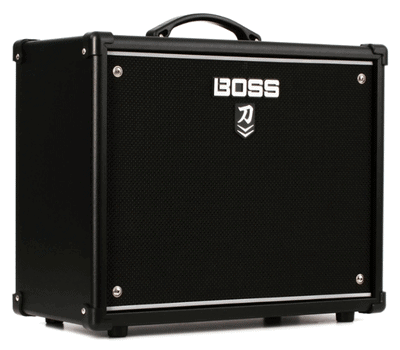
Boss Katana 50 MKII
An amazing feature set and huge aftermarket support.
This is one of the most popular amps on the market for good reason. It’s affordable, offers an almost limitless range of tones, and thanks to the huge online Katana community, there’s no shortage of profiles and models to meet your every tonal need.
The Boss Katana 50MKII has been on the market for a few years now and it continues to impress. It’s a 50-watt amp that will serve the needs of the vast majority of players. And thanks to the intuitive companion software, it can put out just about any tone you could dream up – and all for less than $300.
It was extremely well made – the cabinet in particular felt solidly put together, with no rattles or shakes even when the amp was cranked. It was fitted with a Boss 12″ Special Design Speaker for a full and balanced sound, and also equipped with an attenuator to switch between 50, 25, and 0.5 watts. This makes it a great choice for everything from at-home practice to studio recording sessions and live performances.
It had a well thought out, top-mounted control panel with an extensive array of functions. From here we were able to access the 5 voicings – Acoustic, Clean, Crunch, Lead and Brown. In each setting we were able to adjust the tone via the 3-band EQ and add additional textures with its range of built-in FX.
We did find that due to the overwhelming number of effects available, the control panel made it a little difficult to see at a glance exactly what we had loaded, which ultimately required us to rely on the companion app. If you’re looking for an amp you can squeeze every last ounce of performance from right out of the box, this might not be the amp for you.
Regardless, we still got some great tones from the Katana. It delivered some great cleans, really versatile crunch, and even some heavy distortion, all without the need for external FX units.
On top of the superb amp performance, it also offered USB interface functionality and allowed us to record through a DAW without the need for additional hardware.
Verdict: The Boss Katana 50MKII is an amazing amp with genuinely great tones. It’s one of the most versatile amps on the market and you’ll be hard pressed to find a more feature-rich model for the price. It’s loud enough to keep up with a drummer and still flexible enough to give great tones at bedroom levels. This is a great option for players of all ability levels.
- High quality sound
- Robust construction
- Attractive design
- Clunky editor software
- Too quiet for jams
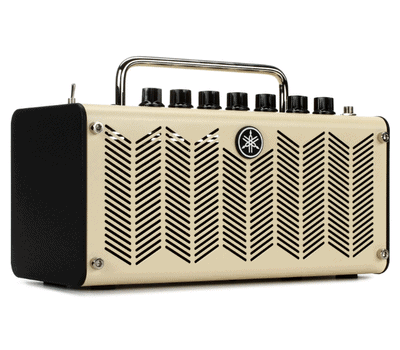
Yamaha THR5
Boutique amp looks in a compact solid state package.
This is one of the most popular desktop amps on the market, and was one of the first to usher in the current generation of compact solid state models with high end features and performance. It offers a number of amp voicings and even USB interface functionality, making it a truly versatile unit.
We’ve long been fans of the Yamaha THR5, with its perfect blend of form and function. Yamaha has absolutely nailed the aesthetics, resulting in an amp that looks like a high-end stereo, so it won’t look out of place in even the most minimalist of living rooms (full review here).
It’s a 10-Watt unit encased in a plastic and metal housing, which gives it an extremely robust feel. It has a pair of high-quality 3″ speakers which remained composed even at high volume. Although high volume is relative, of course, as this was among the quietest of the amps on test.
Like the Katana 50, it had 5 distinct amp voicings. The models included were Clean, Crunch, Lead, Brit Hi, and Modern. Our favorites were Clean, Crunch, and Brit Hi. The Cleans were bright with fantastic clarity. In Crunch, we got some Fender-style soft rock overdrive, and we thought Brit Hi sounded a lot like a classic vintage Marshall Plexi tone.
It came with a range of built-in effects, too. There were 4 reverb and delay effects, plus 4 different modulation settings. It was great to have these built-in, but if you’re serious about creating unique custom sounds, you’ll need to use the Yamaha THR editor app, which we actually found to be a bit clunky.
Like some of the other modelers we included, it did feature USB-out, which allowed us to use it as a recording interface. If you’ve been thinking about starting to record your playing, this is a great way to go, as you won’t have to buy a separate device.
Verdict: The Yamaha THR5 is a great little amp for home use. It’s ideal for bedroom players and those looking to start recording their playing. It’s easily one of the best looking amps on the market and the sound quality is spectacular. If design and build quality are high on your must-haves list, this is a great choice for you!
- High quality sound
- Robust construction
- Attractive design
- Clunky editor software
- Too quiet for jams
How to Choose the Right Amp for You
When shopping for a solid-state amp, you’ll be looking for a different feature set than you would if shopping for a tube amp. With that in mind, we’ve prepared the below guide to help you navigate your way through the huge number of solid-state amps on the market and find the best one for you.
Power
Especially if you’re coming to a solid-state amp from a tube amp, you’ll need to know that the way power is handled is different. This leads to the perception that watt for watt, solid-state amps are quieter than tube amps.
This largely happens because of the speaker impedance. On a solid-state amp, the signals received by the speakers are hard-clipped, which results in a greater resistance and means less of the available power can be utilized.
The resulting effect is that even though a 15-watt tube amp and a 15-watt solid-state amp do indeed have the same power, the 15-watt tube amp is about as loud as a 50-watt solid-state amp.
Modeling Functionality
Solid-state amps have come a long way since their introduction in 1966, and they continue to get more advanced every year. While solid-state amps utilize similar transistor technology to their forebears and offer little else than pure amplification, some of the newer solid-state amps now offer modeling technology.
Amps with modeling functionality have the ability to emulate real amplifiers and effects with a surprising degree of accuracy. With today’s digital tech, they can be used to recreate the sound of a specific amplifier or even the exact tone used on a certain song.
Modeling amps tend to have big online communities in which players share models they’ve made, many of which can be downloaded for free and plugged into your amp, giving you new sounds without the hassle.
If you’re a bit more adventurous, you can even create your own models using the companion software usually available on the manufacturer’s website.
Head vs. Combo
You might also be faced with the decision of choosing between a combo amp or a head. Combo amps have the amplifier unit and a speaker (or multiple speakers) contained within the same cabinet or enclosure. Heads, on the other hand, contain just the amplifier unit with no speakers.
Combos are the most common choice because of their convenience, but can often be cumbersome and can be limiting if performing at a larger venue.
Heads provide a huge amount of flexibility in terms of being able to get a range of tones from different speaker cabs, but without a separate cab (or a reactive loadbox), they’re not much use for practice.
Final Thoughts
Again, solid-state amps have a lot going for them! Many players mistakenly believe that tube amps are the golden goose that will get them the world’s greatest tone and perhaps even make them a better player. We love tube amps at KGR, but we’re also realists. We know the vast majority of players couldn’t hear the difference between a solid-state and a tube amp in a blind test.
To sum up this review – our Top Pick was the Marshall MG50GFX. It has the classic Marshall look, and most importantly, the big British tone. Our Budget Pick was the Boss Katana Mini, a fantastic little modeler that weighs next to nothing, while delivering huge tone and tons of variety. Finally, our Editor’s Choice was the Roland Jazz Chorus JC-120. This is an absolute icon of an amp, and is the choice of professionals the world over for its clean tones, pedal performance, and massive volume.

